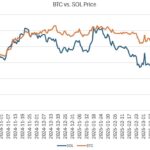Aave users now have the opportunity to engage with Ripple’s newest stablecoin, RLUSD, on its decentralized lending platform. Announced in a recent post on X, Aave stated that users can both supply and borrow RLUSD within the Ethereum Core market, further enhancing its robust offerings in the peer-to-peer lending space.
RLUSD is designed to maintain a stable value pegged 1:1 to the U.S. dollar, functioning across both the XRP Ledger and Ethereum blockchain. The stablecoin is fully backed by a combination of U.S. dollar deposits, short-term U.S. Treasuries, and cash equivalents, ensuring that each RLUSD token corresponds to an equivalent fiat value. With a supply cap set at 50 million and a borrowing limit of 5 million, Aave’s market for RLUSD is designed for stability and security.
“The addition of RLUSD is a strategic move that could reshape how users interact with stablecoins,” said an industry expert.
Security features built into RLUSD make it particularly appealing to institutional investors. Notably, a significant amendment to the XRP Ledger introduced a “clawback” feature that allows the issuer to reclaim specific tokens under certain conditions. This functionality not only enhances security but also assures users regarding the integrity of their assets.
The introduction of RLUSD is poised to stir competitive currents in the cryptocurrency market, particularly against established players like Tether’s USDT and Circle’s USDC. Industry leaders suggest that Ripple’s entry into the stablecoin arena could amplify interest in XRP as well, presenting fresh dynamics for investor engagement.

Aave Introduces Ripple’s RLUSD Stablecoin
Here are the key points regarding Ripple’s RLUSD stablecoin now available on Aave’s platform:
- Aave Integration: Users on Aave can supply and borrow the RLUSD stablecoin, enhancing liquidity options on the V3 Ethereum Core market.
- Supply and Borrow Limits: The market has a supply cap of 50 million RLUSD and a borrow cap of 5 million RLUSD, regulating the stablecoin’s usage.
- Stablecoin Details:
- RLUSD is pegged 1:1 to the U.S. dollar.
- It operates on both the XRP Ledger and the Ethereum blockchain.
- Fully backed by U.S. dollar deposits, short-term U.S. Treasuries, and cash equivalents.
- Security Features: RLUSD incorporates security measures appealing to institutional users, including a clawback feature that allows issuers to reclaim tokens under specific conditions.
- Market Impact: Analysts suggest RLUSD may alter the competitive landscape, challenging established stablecoins like Tether’s USDT and Circle’s USDC.
- Investor Interest: The introduction of RLUSD could enhance the attractiveness of XRP, benefiting investors looking into Ripple’s ecosystem.
As RLUSD gains traction, users may explore new lending opportunities while remaining cautious of the impacts on existing stablecoin dynamics.
Aave Integrates Ripple’s RLUSD: A Game-Changer in the Stablecoin Market
The recent announcement by Aave allowing users to supply and borrow Ripple’s RLUSD stablecoin marks a significant development in the decentralized finance (DeFi) ecosystem. Ripple’s RLUSD is making waves, particularly with its appearance on Aave’s esteemed V3 Ethereum Core market. This integration may lead to a notable shift in market dynamics, especially in the realm of peer-to-peer lending, with a supply cap of 50 million RLUSD and a borrowing limit of 5 million RLUSD.
Competitive Advantages: The real strength of the RLUSD lies in its robust backing and innovative features. Fully backed by U.S. dollar deposits, short-term U.S. Treasuries, and cash equivalents, investors may perceive RLUSD as a more secure alternative compared to existing stablecoins. The added “clawback” feature from the XRP Ledger, introduced earlier this year, offers a layer of security that appeals particularly to institutional users who may demand stricter risk management protocols.
Furthermore, the proximity of the RLUSD to Ethereum and the XRP Ledger enhances its usability across two prominent blockchain networks, potentially giving it an edge over competitors like Tether’s USDT and Circle’s USDC, which are already dominant players in the stablecoin market. This versatility could attract both DeFi enthusiasts and traditional investors alike, increasing liquidity and market participation.
Competitive Disadvantages: Despite these advantages, Ripple’s RLUSD may face challenges in establishing a foothold against well-entrenched competitors. Tether and Circle have established trust over the years, and their significant market presence gives them a formidable advantage. Users accustomed to these platforms may be hesitant to switch to a newer player like RLUSD, despite its appealing security features.
Moreover, while the clawback feature adds security for institutional users, it may also be viewed as a limitation for individual users who value complete autonomy over their assets. This aspect could deter some DeFi proponents who are more inclined towards the ethos of decentralization and self-custody.
Who Could Benefit and Who Might Face Challenges: Aave’s integration of RLUSD may particularly benefit institutional investors looking for secure, low-risk options in a volatile market. The assurance of backing and the added security features could make RLUSD a favorable choice for these stakeholders. On the flip side, this move may create challenges for established stablecoin platforms, as they will need to adapt to the increased competition and potentially work harder to maintain user trust and market share.
In essence, while Aave’s addition of RLUSD could revolutionize the DeFi landscape, the extent to which it impacts current market dynamics will largely depend on user adoption and the responses of its competitors in the stablecoin arena.

















